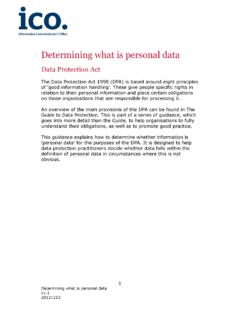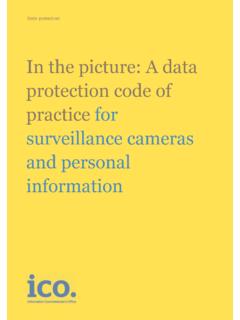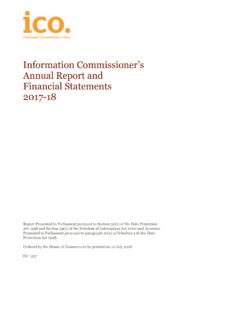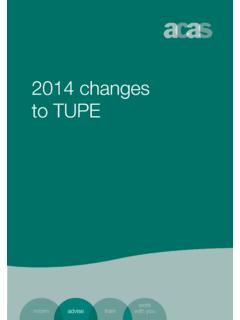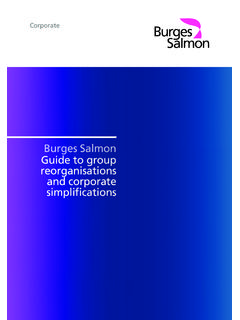Transcription of Disclosure of employee information under TUPE - Home | …
1 ICO lo Disclosure of employee information under tupe . Data Protection Act Contents 2. Overview .. 2. 2. What information must be given to the new employer? .. 3. Can employers disclose this information under the DPA? .. 3. Can employment records be given to the new employer? .. 4. Can the employer keep personal information after a transfer? .. 4. Good practice tips .. 5. More information .. 6. Disclosure of employee information under tupe . 20140602. Version: Introduction 1. The Data Protection Act 1998 (the DPA) is based around eight principles of good information handling. These give people specific rights in relation to their personal information and place certain obligations on those organisations that are responsible for processing it 2. An overview of the main provisions of the DPA can be found in The Guide to Data Protection.
2 3. This is part of a series of guidance, which goes into more detail than the Guide, to help data controllers to fully understand their obligations and promote good practice. 4. This guidance explains what organisations need to do to comply with the DPA when providing information about their employees under the Transfer of Undertakings (Protection of Employment). Regulations 2006 as amended by the Collective Redundancies and Transfer of Undertakings (Protection of Employment). (Amendment) Regulations 2014 (known as tupe ). Overview tupe requires that the new employer is provided with specific details about their new workforce in advance of any transfer or change in service provision. Some employers are unsure how they can comply with the DPA and tupe when disclosing personal information about their employees.
3 The DPA permits these disclosures because they are required by law. But parties must comply with the data protection principles when handling personal information . tupe . 5. tupe is designed to preserve employees' terms and conditions of employment when either a business or undertaking is transferred to a new employer, or there is a service provision change' (for example, contractor A takes on a contract to provide a service for a client from contractor B and the same staff provide the service). These transfers or changes in service provision are referred to as relevant transfers'. 2. Disclosure of employee information under tupe . 20140602. Version: What information must be given to the new employer? 6. tupe requires that the following information (known as employer liability information ') must be given to the new employer before the transfer takes place.
4 Identity (usually the name) and age of the employees who will transfer. information contained in their statements of employment particulars', such as written statement of pay, hours of work, holidays and so on (usually contained in the employee 's offer letter or contract of employment). information about any relevant collective agreements. Details of any disciplinary action taken against an employee in the last two years. Details of any grievance action raised by an employee in the last two years. Details of any legal action (before the court or employment tribunal) brought against the employer by an employee in the last two years and information about any potential legal action. 7. Following amendments to the tupe regulations in 2014, for transfers which take place on, or after 1 May 2014, employers must provide this information at least 28 days before the transfer is completed (previously 14 days).
5 If special circumstances make this impractical, employers should supply it as soon as possible. 8. For more general information about the amendments introduced by the Collective Redundancies and Transfer of Undertakings (Protection of Employment) (Amendment) Regulations 2014, see the ACAS leaflet, 2014 changes to tupe ' ( ). Can employers disclose this information under the DPA? 9. Employers must disclose the information required under tupe . and face penalties if they do not. The DPA allows this Disclosure because it is required by law. However, both parties must take care to comply with data protection principles when handling this personal information . For example: 3. Disclosure of employee information under tupe . 20140602. Version: some transfers are outside the scope of tupe (such as share takeovers).
6 In the early stages of the sale of a business there may be a number of potential bidders, only one of whom will become the eventual new employer but all of whom need the information to assess whether to pursue the purchase; or the prospective new employer may request more information than is required under the tupe regulations. 10. Wherever possible, the employer should release information that is anonymous or, at the very least, should remove obvious identifiers such as name. Employers should only disclose this extra information with the consent of the individuals concerned, or put in place appropriate safeguards to make sure that the information will only be used in connection with the proposed business transfer and will not be kept once it has been used for this purpose.
7 11. For more detail on handling requests for information in relation to employment records, see the ICO Employment Practices Code on Can employment records be given to the new employer? 12. It is likely that once the transfer has taken place the new employer will need a large proportion of an individual's employment record to manage the workforce and run the business. The former employer would not need the employees'. consent to the transfer of their personal information if it was necessary for the purpose of the transfer and business needs of both parties. The new employer should consider whether all the information in the personnel files is needed and delete or destroy and unnecessary information . Can the employer keep personal information after a transfer? 13.
8 The former employer will normally have to keep some personal information about former employees, for example to deal with any liabilities. The DPA permits this, as long the former employer has a justifiable need to keep the information , and 4. Disclosure of employee information under tupe . 20140602. Version: only keeps it for as long as necessary. The former employer should delete or destroy securely any information they do not need to keep. Good practice tips Think about data protection early in the tupe process. Agree what information you should transfer, and how, well before a transfer takes place. Make sure those responsible for negotiating the transfer of staff are aware of their responsibilities to comply with the data protection principles, for example, to keep personal data up to date and secure.
9 Make sure you transfer enough information to meet your tupe obligations and to allow the new employer to run the business and manage the staff. However, both parties should make sure that excessive and irrelevant information is not transferred. Make sure any information handed over is used only for the purposes of tupe until the transfer of staff is completed. Tell employees that their information will be passed to the new employer. This may not always be possible, if for example, insider training' restrictions apply. Consider whether personal information could be anonymised before providing any information which is not required by tupe . Make sure, once the transfer of staff has been completed, that employment records are accurate, relevant and up to date, and any unnecessary information is destroyed securely.
10 5. Disclosure of employee information under tupe . 20140602. Version: More information 15. Additional guidance is available on our guidance pages if you need further information on other parts of the DPA. 16. This guidance has been developed drawing on ICO experience. Because of this it may provide more detail on issues that are often referred to the information Commissioner than on those we rarely see. The guidance will be reviewed and considered from time to time in line with new decisions of the information Commissioner, Tribunals and courts. 17. It is a guide to our general recommended approach, although individual cases will always be decided on the basis of their particular circumstances. 18. If you need any more information about this or any other aspect of data protection, please contact us, or visit our website at 6.
